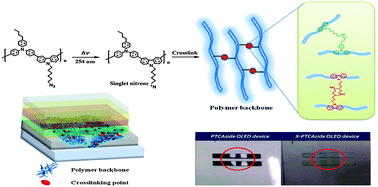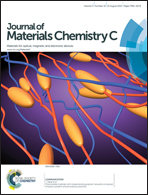A solvent-resistant azide-based hole injection/transporting conjugated polymer for fluorescent and phosphorescent light-emitting diodes†
Abstract
Interfacial mixing of polymers is a critical issue when attempting to improve the charge transport and stabilize the operation of solution-processed organic light-emitting diodes (OLEDs). Herein, we describe a simple methodology for overcoming interfacial mixing, based on the use of a photo-crosslinkable hole injection/transporting material (HITM). We synthesized a conjugated polymer, PTCAzide, bearing ready crosslinking ability and investigated its suitability for use as an HITM. Photo-crosslinking of the PTCAzide copolymer gave X-PTCAzide, which exhibited much higher thermal stability (the glass transition temperature increased by 21 K relative to that of PTCAzide), remarkable electrochemical stability, and excellent solvent-resistance, thereby expanding the operation time of corresponding electronic devices. Such a tris(8-hydroxyquinolinato)aluminum-based trilayer device reached a maximum brightness of 52 971 cd m−2, and the maximum luminance efficiency (LE) and power efficiency (ηE) are both higher than those of the corresponding device based on commercial PEDOT : PSS. In addition, a solution-processed phosphorescent OLED device incorporating X-PTCAzide also exhibited good performance (external quantum efficiency: 7.93%; LE: 29.6 cd A−1; ηE: 14.3 lm W−1; maximum brightness: 34 484 cd m−2). The efficient and simple photocrosslinking without adding an initiator could facilitate the fabrication process. Thus, PTCAzide appears to be a promising next-generation HITM for the development of highly efficient and inexpensive OLEDs. Its photo-crosslinkable nature allows improvements in morphological stability and hole injection/transporting ability, leading to more stable devices with better operation, without disrupting molecular packing or charge transport.


 Please wait while we load your content...
Please wait while we load your content...